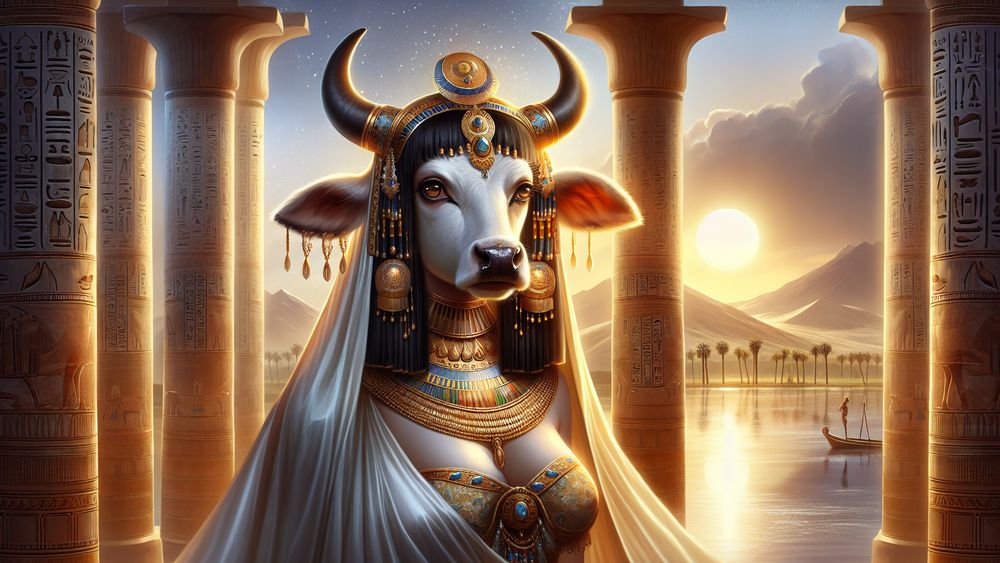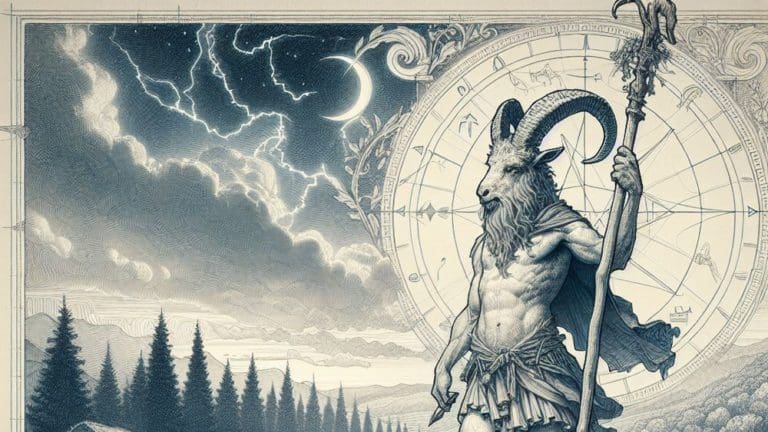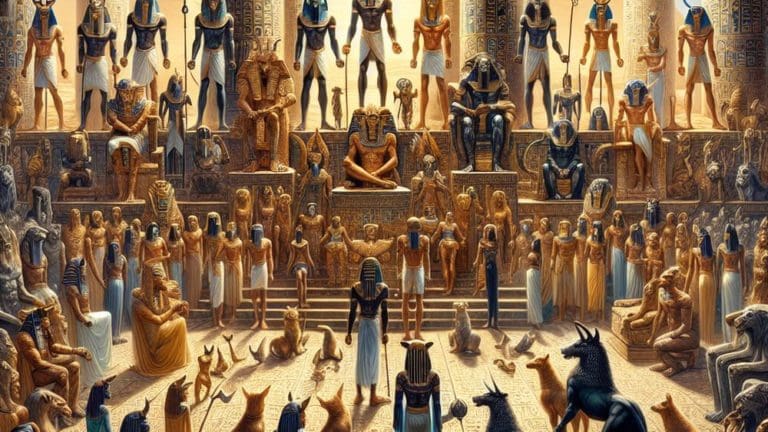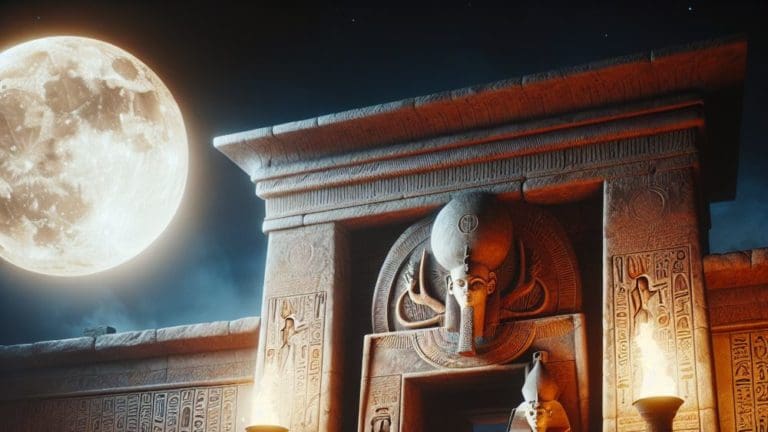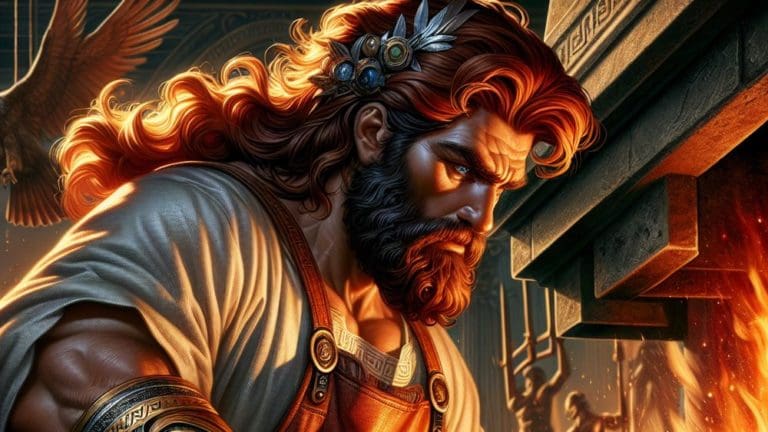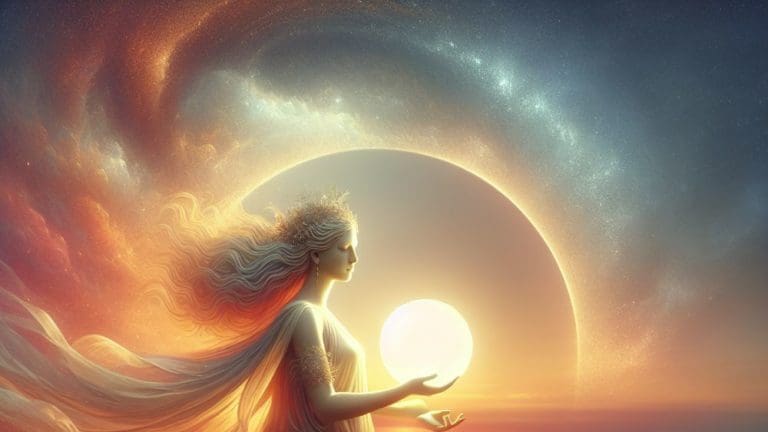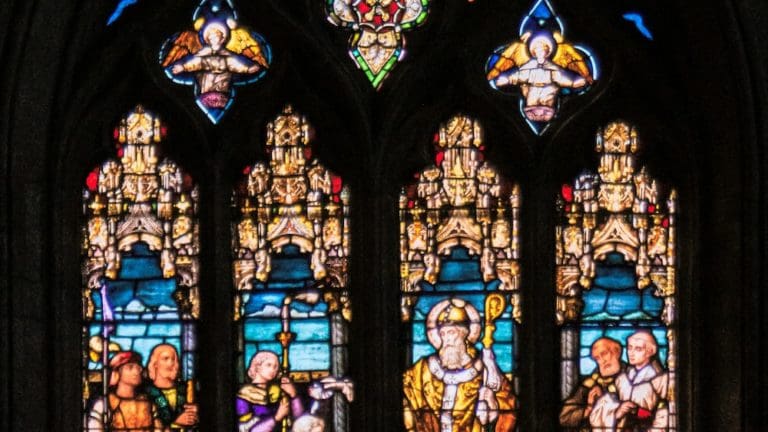Hathor: Egyptian Goddess Of Love And Motherhood
So, we’re heading straight into the world of ancient Egypt. Here, Hathor shines bright. She’s all about love, beauty, and being a mom. But that’s scratching the surface. Her story and impact go way, way back and far out. They reach places and people outside Egypt too. This trip we’re taking? It’s to see all sides of Hathor.
Key Points:
- Hathor is the Egyptian goddess of love, beauty, and motherhood.
- She was worshipped for her roles as a sky goddess and goddess of love and beauty.
- Hathor was often symbolized with a cow’s head and a sun disk with cow horns.
- Festivals and celebrations dedicated to Hathor involved music, dance, and light beer drinking.
- Hathor’s influence extended outside Egypt, impacting foreign lands and cultures.
- She played various roles in Egyptian mythology, including almost wiping out humanity and protecting Horus.
- Hathor’s legacy endorses modern culture through art, literature, and historical significance.
From what she symbolized and which animals were sacred to her, to the stories that feature her and how folks celebrated her. And yes, we’ll see how she still makes waves today. How her tales and symbols keep talking to us, connecting dots from the past right into our now. Let’s get going and really get to know Hathor.
The Many Faces of Hathor
Hathor really shines as a figure with so much to her. We’re heading into a closer look at her and the impact she had on the world of ancient Egypt.
Goddess of the Sky and Love
Hathor, quite the versatile figure in ancient Egypt, held the titles of both sky goddess and goddess of love and beauty. Imagine her as a bridge. On one side, she’s all about the sky, welcoming souls to what comes after life. On the other, she’s the go-to for matters of the heart and beauty, symbolizing motherhood and all that’s fertile.
This mix lets her connect the dots between the here and the divine, placing her at the heart of Egyptian culture and beliefs. Her knack for juggling roles that seem worlds apart – guidance in the afterlife and champion of love and beauty – shines a light on how Egyptians saw their gods and their impact on life and afterlife.
Now, Hathor’s two-sided nature really left its mark on Egyptian ways and worship, revealing their layered take on gods and the afterlife. Picture her as key in ceremonies and beliefs around coming into this world, leaving it, and everything that happens after. Her traits and jobs show how much Egyptians valued balance and harmony in the universe and their own lives.
This idea of balance really comes through when you think about Hathor during major life moments. Whether it’s a birth celebration or a send-off for the departed, she stood as both protector and guide for folks in life and afterlife.
- Hathor often appeared with a cow’s head, which stood for fertility and being a mom.
- She also wore a sun disk with cow horns, linking her to Ra, the sun god.
- Music and dance were key in celebrating Hathor, echoing her ties to joy and festivities.
Hathor’s dual role as sky goddess and goddess of love and beauty symbolized balance and harmony in Egyptian culture and beliefs.
Hathor and Her Family Ties
Hathor really stood out in the Egyptian family of gods. Think of her as Ra’s daughter. That’s a pretty big role, right? She was in the thick of it, connected to almost every part of what the Egyptians thought and felt about their gods. Hathor wasn’t one to stick to a single job.
Her relationships with other gods show us how she could be many different figures all at once. Sometimes, she’s Horus’s mom which ties her closely to Isis, who is more often known for that role. It’s like Hathor could wear many hats, linking her to so many stories and powers in the world of gods. Her connections didn’t stop at being a parent or child.
Hathor and love, beauty, and music were almost the same thing in the minds of her followers. Marrying Horus and sometimes being Ra’s wife put her right at the center of godly power plays. These ties were more than family links. They showed how everything in the divine world was connected.
Hathor was a key player, making sure all these connections stayed strong while keeping her own special place in people’s hearts and minds.
| Relation | Deity | Role/Significance |
|---|---|---|
| Parent | Ra | Shows where Hathor comes from and her power |
| Child | Horus | Puts a spotlight on her as a caring mother and her link to leadership |
| Spouse | Horus/Ra | Her partners, which can change depending on the story, show her role in bringing gods together |
| Sibling | Sekhmet | Her sister, which points to another side of Ra and contrasts between love and war |
Hathor’s Iconography and Worship
So, we’ve talked about Hathor’s many roles and where she fits in her big family. Now, let’s shift gears and look at how people in ancient Egypt showed and honored her.
Symbols and Sacred Animals
Hathor, that Egyptian goddess we talk so much about for love and motherhood, has her own set of signs and animals that mean a lot. Take the sistrum for example. It’s a kind of musical tool that people used when they wanted to worship her. They thought it carried the soothing sounds of her music which was all about bringing happiness and safety. Then there’s the menat necklace.
This piece was all about fertility and starting anew, which makes sense since Hathor was seen as a motherly figure and a guardian for women and kids. These weren’t simply for show. They played a huge part in how people practiced their religion and tried to get the goddess’s good graces. Now, for the animals that were special to Hathor. The cow tops this list.
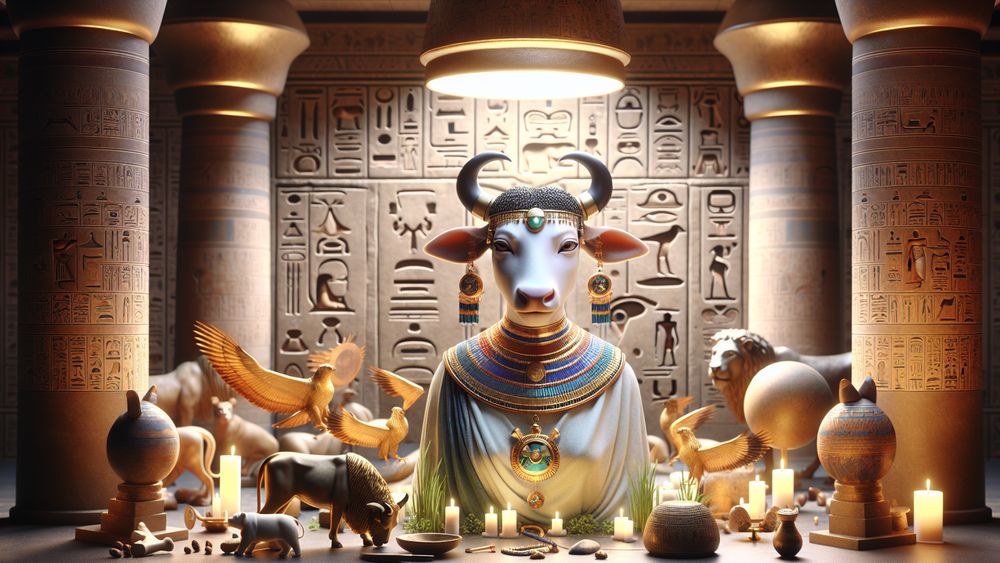
It stood for motherhood and the sky, which fits since Hathor was also a sky goddess. You’d often see her pictured with cow ears or even as a cow which was the people’s way of honoring her caring and protective sides. Then there were lions and falcons which showed her tougher side and her connection to Horus, another god.
Art and worship items were full of these animals which helped people feel closer to Hathor and show their respect. When it came to art and how people worshipped, these symbols and animals were everywhere. From temple walls and paintings to little amulets in homes. They used them in so many rituals, both in public and in private, aiming to win Hathor’s favor and protection.
Playing sistrums during religious events was meant to calm the goddess while wearing menat necklaces was thought to bring fertility and keep away bad spirits. Through these symbols and sacred animals, Hathor became a part of everyday life for the ancient Egyptians, giving them comfort and guidance while keeping her as a beloved figure in their beliefs.
Festivals and Celebrations in Honor of Hathor
So, Hathor’s parties were something else. Take the Festival of the Sacred Marriage for example. It was all about Hathor and Horus coming together which was a huge thing for her followers. Imagine streets and temples alive with music and dance, and everyone in high spirits. This wasn’t your average get-together.
It was a full-blown celebration where joy and laughter were the orders of the day. Then there’s the Feast of Drunkenness. Sounds wild, right? But it was actually quite meaningful. It remembered how Hathor saved humanity and involved drinking beer which was specially brewed to be very light. Everyone could join in without really getting drunk.
These events were key for connecting with Hathor and getting her blessings for love and happiness. Now, why were these festivals so crucial? They kept society ticking. By joining in, people felt closer to the gods and the universe. Hathor’s festivals, especially, were about happiness, fertility, and starting anew which really mattered to the Egyptians.
It was a time when everyone, from pharaohs to farmers, came together to show Hathor some love and thank her for her blessings. Her influence was everywhere, making her one of the most adored deities around. Through these festivals, Hathor’s presence was felt across Egypt, which says a lot about how much they adored her.
- Music and processions made Hathor’s festivals unforgettable.
- Light beer drinking at the Feast of Drunkenness brought everyone together in a meaningful way.
- Everyone joining in helped strengthen community ties and devotion.
Hathor’s festivals were crucial for strengthening community ties and devotion through music, dance, and light beer drinking, ultimately connecting people with the gods and the universe.
Hathor’s Influence Beyond Egypt
Hathor, while starting her story in Egypt, didn’t stay put. Her impact stretched far and wide, touching places and people far from the Nile. Let’s take a look at how this goddess made her mark well outside Egypt’s borders.
Hathor and Foreign Lands
Hathor didn’t stay put in Egypt. She reached out, touching places far and wide. Think of her as Egypt’s ambassador to the world of ancient trade and cultural exchange. She had a thing for shiny and fragrant goods like myrrh and incense. These weren’t your everyday items but treasures from distant lands.
People brought them to her temples as gifts, which says a lot about her taste and influence. Hathor stood for more than what met the eye. She was a bridge to the outside world, making her a key player in how Egyptians saw and interact with lands far from their own.
Her story tells us that the ancient Egyptians weren’t isolated. They were curious and open, with Hathor leading the charge into uncharted territories. This goddess wasn’t limited by geography. Her reach and role show us how interconnected and dynamic the ancient world was.
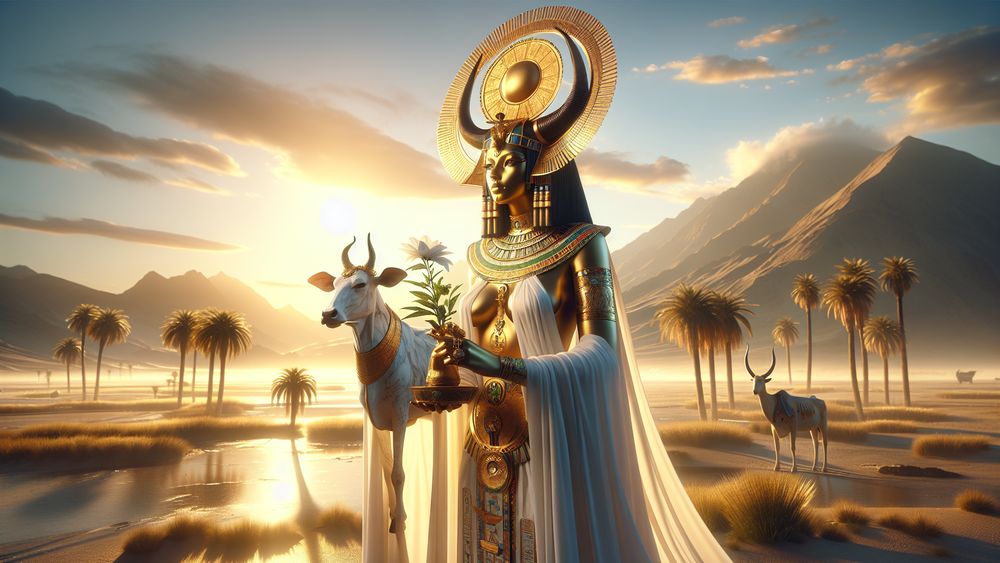
The Spread of Hathor’s Cult
So, Hathor’s story didn’t stay put in Egypt. It traveled far and wide. Thanks to traders and conquerors, her name and stories reached places you wouldn’t expect. Places like Nubia and the Near East got to know her, love her, and even worship her. They had their own takes on Hathor, which is pretty neat when you think about it.
It’s like when a song covers so many genres and still hits the right notes every time. This blending of beliefs showed how flexible and open-minded people were about their gods and goddesses back then. Hathor became a bit of a mix and match with local deities which, honestly, made her even more popular. It wasn’t simply about spreading a name; it was about sharing ideas and values.
That’s the power of Hathor’s cult. It built bridges between cultures and stood the test of time and geography. Pretty impressive for an ancient Egyptian goddess, right?
Hathor’s story spread far and wide, reaching unexpected places and cultures, demonstrating the power of blending beliefs and building bridges between people.
Hathor in Myths and Legends
So, we’ve talked about Hathor’s roles and symbols. Now, let’s jump into the tales that bring her to life in Egyptian myths.
Key Myths Involving Hathor
So, we’ve got this story where Hathor almost wipes out humanity. She turns into Sekhmet because Ra, the sun god, is fed up with people’s misbehavior. But before she can finish the job, Ra calls it off. This tale really drives home how Hathor can be both loving and quite fearsome when pushed.
It’s a powerful message about keeping balance and respecting those above us. Then there’s her bond with Horus. After Horus loses his dad, Osiris, Hathor steps in. She’s like this super protective figure for him. It’s a heartwarming example of how she’s all about motherhood and keeping an eye out for others. This story tells us a lot about the value of care and protection in the eyes of the Egyptians.
Aside from these, Hathor’s adventures cover a lot. We see her dealing with themes like making amends, safeguard and the sheer strength of kindness and empathy. These stories weren’t simply for kicks. They taught valuable life lessons while keeping folks entertained. Through tales of redemption and the importance of nurturing care, Hathor’s myths highlighted what it meant to live well and in harmony with the divine and each other.
- Hathor nearly ends humanity as Sekhmet but stops, which underpins the importance of divine balance and respect.
- Her protective role for Horus after Osiris’s demise illustrates her maternal qualities.
- The myths around Hathor often focus on learning from mistakes, safeguard, and the power of kindness and empathy, which were central to Egyptian values.
The Legacy of Hathor Today
We’ve dug into the stories and myths that spotlight Hathor as a key player in the world of Egyptian myths. It’s pretty clear her touch reaches wide into today’s world. Now, let’s see how folks keep this ancient goddess in mind and echo her essence nowadays.
Hathor’s Influence on Modern Culture
Today, we still see Hathor’s touch in movies, books, and even video games. She’s that ancient Egyptian goddess who knew all about love and beauty. Artists and writers find her quite inspiring. They take her old stories and give them a new twist for people to enjoy now. It’s pretty amazing how she fits into so many different stories and art pieces.
Her symbols and tales from thousands of years ago still capture our imagination. That’s the power of Hathor for you. Aside from entertainment, Hathor keeps popping up in serious talks about history and myths. Experts love to share her stories. They tell us what she meant to people long ago and why we should care now. Museums around the world showcase her, and scholars write papers about her importance.
It’s like she bridges the gap between the ancient and the modern. Hathor makes us think about love, protection, and beauty in ways that still matter. She’s got staying power, that’s for sure.
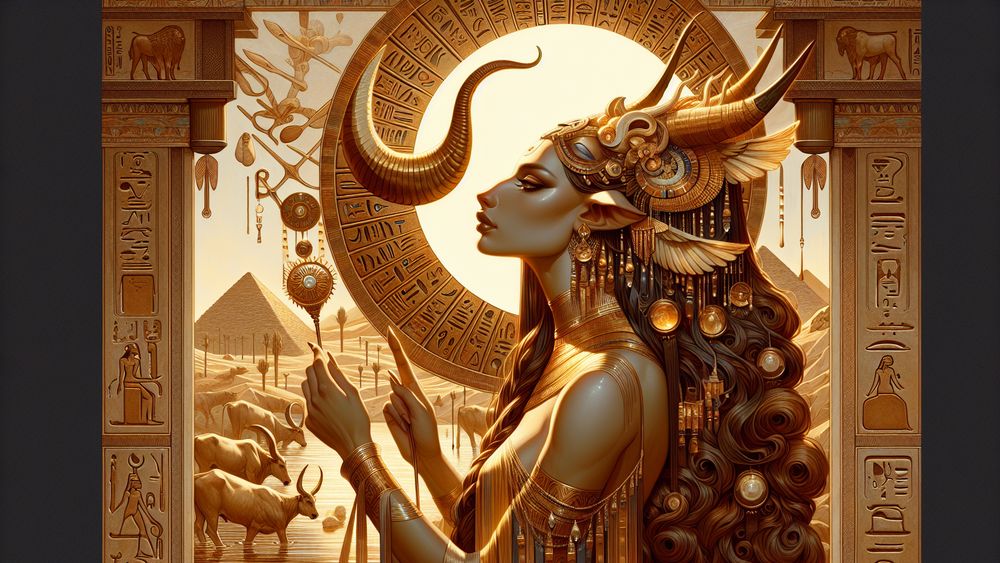
Pantheon of All the Egyptian Mythology Gods
So, we’re heading into a world where gods and goddesses are a big thing. The Egyptian mythology? It’s like a huge, colorful quilt of stories and characters. You’ve got Ra, the sun god, doing his daily sky cruise and night-time underworld adventures. Then there’s Isis, all about magic and being a mom.
Each god or goddess has their own special area and tales that go way back. If you’re looking to get the full scoop on this crowd, a detailed list can really open your eyes. For anyone ready to jump in, here’s a list of all the Egyptian gods that serves as your ticket to a world that has kept people hooked for ages.
FAQs
1. Who were Hathor’s parents and did she have any siblings?
So, when we talk about Hathor and where she comes from, it’s quite the story. Ra, the mighty sun god, claims the title of her dad. That’s right. And then there’s Horus, the one who rules the sky. He’s in the mix as her brother.
2. What are the most famous symbols and animals connected to Hathor?
When we talk about Hathor, two symbols really jump out. First up, we’ve got the cow. It’s all about that caring and motherly vibe she’s known for. Then, there’s the sistrum. Think music and dancing, which totally fits her joyful side.
3. Can you name a few festivals that were dedicated to Hathor and how they were celebrated?
Sure, let’s talk about the Festival of the Valley for starters. People really got into it with music and dancing. It was all about giving it up for Hathor and her ties to making crops grow and life after death. Imagine the scene: everyone heading to Hathor’s temples, bringing gifts and really living it up in her honor. It was a time when joy filled the air and everyone came together for a good time.
4. How did Hathor’s worship influence other cultures outside of Egypt?
So, Hathor really got around, touching hearts and minds far from her Egyptian home. She didn’t stay put. Her stories and rituals found new homes and people. They mixed and mingled with local traditions. This blending created something fresh and exciting.
It’s like when you add a new ingredient to your favorite recipe and it brings out flavors you never knew were there. Hathor did that for spiritual practices in places far and wide. Her impact? Huge and still felt today.

